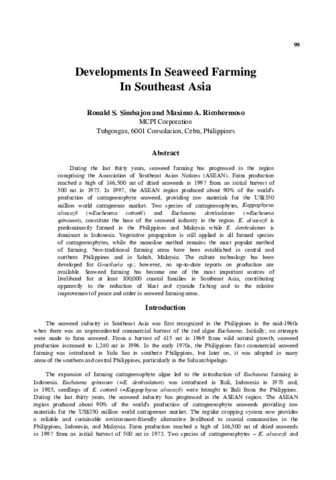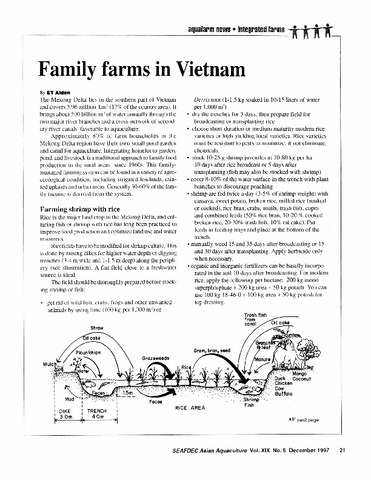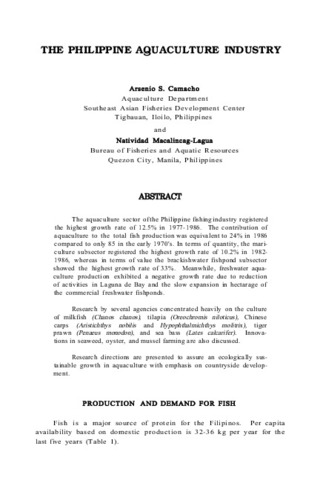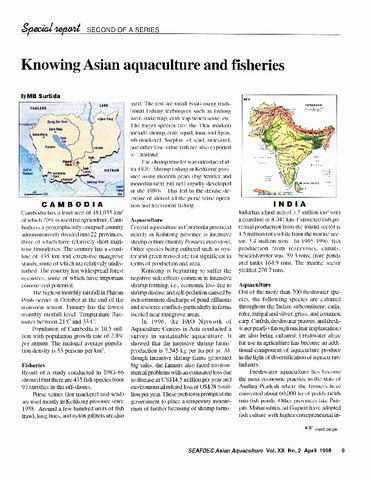Developments in seaweed farming in Southeast Asia

ရှာဖွေ/ဖွင့်ပါ။
ရက်စွဲ
2001Page views
593
Share
စိတ္တဇ
During the last thirty years, seaweed farming has progressed in the region comprising the Association of Southeast Asian Nations (ASEAN). Farm production reached a high of 146,500 mt of dried seaweeds in 1997 from an initial harvest of 500 mt in 1973. In 1997, the ASEAN region produced about 90% of the world s production of carrageenophyte seaweed, providing raw materials for the US$35O million world carrageenan market. Two species of carrageenophytes, Kappaphycus alvarezii (=Eucheuma cottonii) and Eucheuma denticulatum (=Eucheuma spinosum), constitute the base of the seaweed industry in the region. K. alvarezii is predominantly farmed in the Philippines and Malaysia while E. denticulatum is dominant in Indonesia. Vegetative propagation is still applied in all farmed species of carrageenophytes, while the monoline method remains the most popular method of farming. Non-traditional farming areas have been established in central and northern Philippines and in Sabah, Malaysia. The culture technology has been developed for Gracilaria sp.; however, no up-to-date reports on production are available. Seaweed farming has become one of the most important sources of livelihood for at least 100,000 coastal families in Southeast Asia, contributing apparently to the reduction of blast and cyanide fishing and to the relative improvement of peace and order in seaweed farming areas.
Suggested Citation
Simbahon, R. S., Ricohermoso, M. A. (2001). Developments in seaweed farming in Southeast Asia. In L. M. B. Garcia (Ed.), Responsible Aquaculture Development in Southeast Asia. Proceedings of the Seminar-Workshop on Aquaculture Development in Southeast Asia organized by the Aquaculture Department, Southeast Asian Fisheries Development Center, 12-14 October 1999, Iloilo City, Philippines (pp. 99-102). Tigbauan, Iloilo, Philippines: Aquaculture Department, Southeast Asian Fisheries Development Center.
ဘာသာရပ်
စုစည်းမှုများ စုစည်းမှုများ
- ADSEA '99 [21]
Related items
Showing items related by title, author, creator and subject.
-
Family farms in Vietnam
Aldon, Eva T. (Aquaculture Department, Southeast Asian Fisheries Development Center, 1997) -
The Philippine aquaculture industry
Camacho, Arsenio S.; Macalincag-Lagua, Natividad (Aquaculture Department, Southeast Asian Fisheries Development Center, 1988)The aquaculture sector of the Philippine fishing industry registered the highest growth rate of 12.5% in 1977-1986. The contribution of aquaculture to the total fish production was equivalent to 24% in 1986 compared to ... -
Knowing Asian aquaculture and fisheries
Surtida, Marilyn B. (Aquaculture Department, Southeast Asian Fisheries Development Center, 1998-04)This article is the second of four parts.




